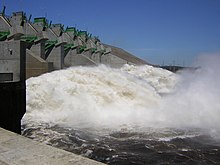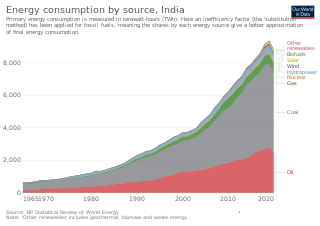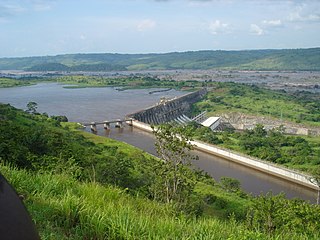
Venezuela was one of the world's largest producers of oil, and the country with the largest proven oil reserves in the world. Venezuela is a member of OPEC.
Contents
Electricity in Venezuela is predominantly produced from hydroelectricity.

Venezuela was one of the world's largest producers of oil, and the country with the largest proven oil reserves in the world. Venezuela is a member of OPEC.
Electricity in Venezuela is predominantly produced from hydroelectricity.
| Capita | Prim. energy | Production | Export | Electricity | CO2-emission | |
|---|---|---|---|---|---|---|
| Million | TWh | TWh | TWh | TWh | Mt | |
| 2004 | 26.1 | 653 | 2,280 | 1,623 | 72.1 | 128 |
| 2007 | 27.5 | 741 | 2,138 | 1,381 | 84.6 | 144 |
| 2008 | 27.9 | 745 | 2,102 | 1,340 | 85.9 | 146 |
| 2009 | 28.4 | 778 | 2,367 | 1,503 | 89.5 | 155 |
| 2010 | 28.83 | 895 | 2,241 | 1,353 | 94.77 | 183.04 |
| 2012 | 29.28 | 816 | 2,335 | 1,506 | 97.73 | 159.22 |
| 2012R | 29.96 | 888 | 2,318 | 1,405 | 101.88 | 178.28 |
| 2013 | 30.41 | 800 | 2,235 | 1,405 | 98.25 | 155.57 |
| Change 2004-10 | 10.3% | 37.0% | -1,7% | -16,6% | 31.4% | 42.6% |
| Mtoe = 11.63 TWh, Prim. energy includes energy losses 2012R = CO2 calculation criteria changed, numbers updated | ||||||
Venezuela ranked 11th in the world for oil production in 2016; production has since fallen steeply. [2] The largest oil company is Petróleos de Venezuela (PDVSA). Oil fields in the country include Bolivar Coastal Field, Boscán Field, Maracaibo Basin and Orinoco Belt.
| 2011 | 2012 | 2013 | 2014 | 2015 | 2016 | 2017 | 2018 | 2019 | 2020 | 2021 |
| 2755 | 2704 | 2680 | 2692 | 2864 | 2566 | 2220 | 1631 | 1022 | 640 | 654 |
In 2023, Venezuela held the world's largest proven oil reserves at 303 billion barrels, accounting for 17% of global reserves, mostly extra-heavy crude from the Orinoco Belt. Despite this, production was only 0.8% of the global total, dropping to 742,000 barrels per day, a 70% decline from 2013. Production rose by 13% in 2021 and 18% in 2022 with help from Iran, China, and Chevron after some sanctions were eased. PDVSA, the state oil company, faces issues like heavy government levies, underinvestment, mismanagement, and a lack of skilled personnel, reducing reinvestment and production. Refineries operate below capacity due to maintenance issues and lack of feedstock. Venezuela relies on fuel imports from Iran and China due to domestic shortages. A territorial dispute with Guyana over the Essequibo region heightened tensions, but both countries agreed to seek a diplomatic resolution. [4]
In 2023, Venezuela held 195 trillion cubic feet (Tcf) of natural gas reserves, making up 73% of South America's total. Most of this gas is associated with crude oil, with 80% produced as a by-product. Despite these vast reserves, much of Venezuela's natural gas is underutilized, used to support mature oil fields or flared due to inadequate infrastructure. Production peaked at 1.12 Tcf in 2001 but fell to 563 billion cubic feet (Bcf) by 2021, hampered by poor investment and lack of infrastructure. Domestic consumption peaked at 936 Bcf in 2015 but dropped to 563 Bcf by 2021 due to economic decline. Venezuela is a major gas flarer, with flaring increasing fourfold from 2012 to 2021, reaching 706 Bcf in 2022. Government-regulated prices and subsidies keep natural gas prices below market rates, further limiting investment in the sector. [4]
| 2011 | 2012 | 2013 | 2014 | 2015 | 2016 | 2017 | 2018 | 2019 | 2020 | 2021 |
| 30.2 | 31.9 | 30.6 | 31.8 | 36.1 | 37.2 | 38.6 | 31.6 | 25.6 | 21.6 | 24.0 |
In 2021, Venezuela held South America's fourth-largest coal reserves, totaling 806 million short tons. The main coalfields are in Zulia State, near the Colombian border. Coal plays a minor role in Venezuela's energy mix, contributing 0.2% to total energy production and 0.1% to consumption. The coal industry faces challenges such as outdated infrastructure and limited investment, leading to a production decline of 16% annually from 2001 to 2021, after peaking at nearly 8.7 million short tons in 2000. By 2021, production was 174 thousand short tons, entirely bituminous coal. Most of Venezuela's coal is used domestically in industrial processes. Consumption peaked at 319,000 short tons in 2012 but dropped to 67,000 short tons by 2021 due to economic decline. [4]
| 2011 | 2012 | 2013 | 2014 | 2015 | 2016 | 2017 | 2018 | 2019 | 2020 | 2021 |
| 0.08 | 0.06 | 0.04 | 0.02 | 0.02 | 0.02 | 0.02 | 0.02 | 0.01 | 0.01 | <0.005 |

Hydro power provided 74% of domestic electricity in 2008. Venezuela produced 87 TWh hydro power in 2008, 2.6% of the world total. Venezuela was top 8th in hydro electricity in 2008. [5]

Japan is a major consumer of energy, ranking fifth in the world by primary energy use. Fossil fuels accounted for 88% of Japan's primary energy in 2019. Japan imports most of its energy due to scarce domestic resources. As of 2022, the country imports 97% of its oil and is the larger liquefied natural gas (LNG) importer globally.
The energy policy of India is to increase the locally produced energy in India and reduce energy poverty, with more focus on developing alternative sources of energy, particularly nuclear, solar and wind energy. Net energy import dependency was 40.9% in 2021-22. The primary energy consumption in India grew by 13.3% in FY2022-23 and is the third biggest with 6% global share after China and USA. The total primary energy consumption from coal, crude oil, natural gas, nuclear energy, hydroelectricity and renewable power is 809.2 Mtoe in the calendar year 2018. In 2018, India's net imports are nearly 205.3 million tons of crude oil and its products, 26.3 Mtoe of LNG and 141.7 Mtoe coal totaling to 373.3 Mtoe of primary energy which is equal to 46.13% of total primary energy consumption. India is largely dependent on fossil fuel imports to meet its energy demands – by 2030, India's dependence on energy imports is expected to exceed 53% of the country's total energy consumption.

Denmark has considerable sources of oil and natural gas in the North Sea and ranked as number 32 in the world among net exporters of crude oil in 2008. Denmark expects to be self-sufficient with oil until 2050. However, gas resources are expected to decline, and production may decline below consumption in 2020, making imports necessary. Denmark imports around 12% of its energy.

Iran possesses significant energy reserves, holding the position of the world's third-largest in proved oil reserves and the second-largest in natural gas reserves as of 2021. At the conclusion of the same year, Iran's share comprised 24% of the oil reserves in the Middle East and 12% of the worldwide total.

Brazil is the 7th largest energy consumer in the world and the largest in South America. At the same time, it is an important oil and gas producer in the region and the world's second largest ethanol fuel producer. The government agencies responsible for energy policy are the Ministry of Mines and Energy (MME), the National Council for Energy Policy (CNPE), the National Agency of Petroleum, Natural Gas and Biofuels (ANP) and the National Agency of Electricity (ANEEL). State-owned companies Petrobras and Eletrobras are the major players in Brazil's energy sector, as well as Latin America's.

China is both the world's largest energy consumer and the largest industrial country, and ensuring adequate energy supply to sustain economic growth has been a core concern of the Chinese Government since the founding of the People's Republic of China in 1949. Since the country's industrialization in the 1960s, China is currently the world's largest emitter of greenhouse gases, and coal in China is a major cause of global warming. China is also the world's largest renewable energy producer, and the largest producer of hydroelectricity, solar power and wind power in the world. The energy policy of China is connected to its industrial policy, where the goals of China's industrial production dictate its energy demand managements.
Venezuela has the largest conventional oil reserves and the second-largest natural gas reserves in the Western Hemisphere. In addition Venezuela has non-conventional oil deposits approximately equal to the world's reserves of conventional oil. Venezuela is also amongst world leaders in hydroelectric production, supplying a majority of the nation's electrical power through the process.

Since 2013, total primary energy consumption in India has been the third highest in the world after China and United States. India is the second-top coal consumer in the year 2017 after China. India ranks third in oil consumption with 22.1 crore tons in 2017 after United States and China. India is net energy importer to meet nearly 47% of its total primary energy in 2019.
Energy in Kazakhstan describes energy and electricity production, consumption and import in Kazakhstan and the politics of Kazakhstan related to energy.

The Energy in Russia is an area of the national economy, science, and technology of the Russian Federation, encompassing energy resources, production, transmission, transformation, accumulation, distribution, and consumption of various types of energy.

Energy in Mexico describes energy, fuel, and electricity production, consumption and import in Mexico.

Vietnam is a dynamic developing economy with a relatively high growth rate. The energy sector plays a key role in promoting the country's socio-economic development. Vietnam has a diverse energy fuel resource of various types such as coal, natural gas, petroleum, hydropower and renewables such as solar and wind energy. The country has recently been successful in renewable energy deployment, especially solar and wind power development. Coal has been the key power generation source since 2018. Coal accounted for about 30% of installed capacity and 47% of electricity generation in 2021 The high use of coal makes Vietnam an increasingly important emitter of carbon dioxide, contributing to climate change.
Energy security of the People's Republic of China concerns the need for the People's Republic of China to guarantee itself and its industries long- term access to sufficient energy and raw materials. China has been endeavoring to sign international agreements and secure such supplies; its energy security involves the internal and foreign energy policy of China. Currently, China's energy portfolio consists mainly of domestic coal, oil and gas from domestic and foreign sources, and small quantities of uranium. China has also created a strategic petroleum reserve, to secure emergency supplies of oil for temporary price and supply disruptions. Chinese policy focuses on diversification to reduce oil imports, which used to rely almost exclusively on producers in the Middle East.

The Democratic Republic of the Congo was a net energy exporter in 2008. Most energy was consumed domestically in 2008. According to the IEA statistics the energy export was in 2008 small and less than from the Republic of Congo. 2010 population figures were 3.8 million for the RC compared to CDR 67.8 Million.

Energy in Australia is the production in Australia of energy and electricity, for consumption or export. Energy policy of Australia describes the politics of Australia as it relates to energy.

In 2019, the total energy production in Indonesia is 450.79 million tonnes of oil equivalent, with a total primary energy supply of 231.14 million tonnes of oil equivalent and electricity final consumption of 263.32 terawatt-hours. From 2000 to 2021, Indonesia's total energy supply increased by nearly 60%.
Energy in Libya primarily revolves around the production, consumption, import, and export of energy, with a significant focus on the petroleum industry, which serves as the backbone of the Libyan economy. As of 2021, Libya is recognized as the seventh-largest crude oil producer in OPEC and ranks third in total petroleum liquids production in Africa. The country holds 3% of the world's proven oil reserves and 39% of Africa's, marking it as a key player in the global energy sector. Despite its abundant resources, the energy industry in Libya has faced significant challenges due to political instability following the civil war that began in 2011. These challenges have led to frequent disruptions in oil production and exports, directly impacting the national economy and its contributions to the global oil market. The sector's future is closely tied to the resolution of political conflicts and the effective management of its vast hydrocarbon resources.
Energy in Algeria encompasses the production, consumption, and import of energy. As of 2009, the primary energy use in Algeria was 462 TWh, with a per capita consumption of 13 TWh. Algeria is a significant producer and exporter of oil and gas and has been a member of the Organization of the Petroleum Exporting Countries (OPEC) since 1969. It also participates in the OPEC+ agreement, collaborating with non-OPEC oil-producing nations. Historically, the country has relied heavily on fossil fuels, which are heavily subsidized and constitute the majority of its energy consumption. In response to global energy trends, Algeria updated its Renewable Energy and Energy Efficiency Development Plan in 2015, aiming for significant advancements by 2030. This plan promotes the deployment of large-scale renewable technologies, such as solar photovoltaic systems and onshore wind installations, supported by various incentive measures.
Energy in Iraq plays a crucial role in both the national economy and the global energy markets due to the country's vast oil reserves and significant status within the Organization of the Petroleum Exporting Countries (OPEC).

World energy supply and consumption refers to the global supply of energy resources and its consumption. The system of global energy supply consists of the energy development, refinement, and trade of energy. Energy supplies may exist in various forms such as raw resources or more processed and refined forms of energy. The raw energy resources include for example coal, unprocessed oil & gas, uranium. In comparison, the refined forms of energy include for example refined oil that becomes fuel and electricity. Energy resources may be used in various different ways, depending on the specific resource, and intended end use. Energy production and consumption play a significant role in the global economy. It is needed in industry and global transportation. The total energy supply chain, from production to final consumption, involves many activities that cause a loss of useful energy.